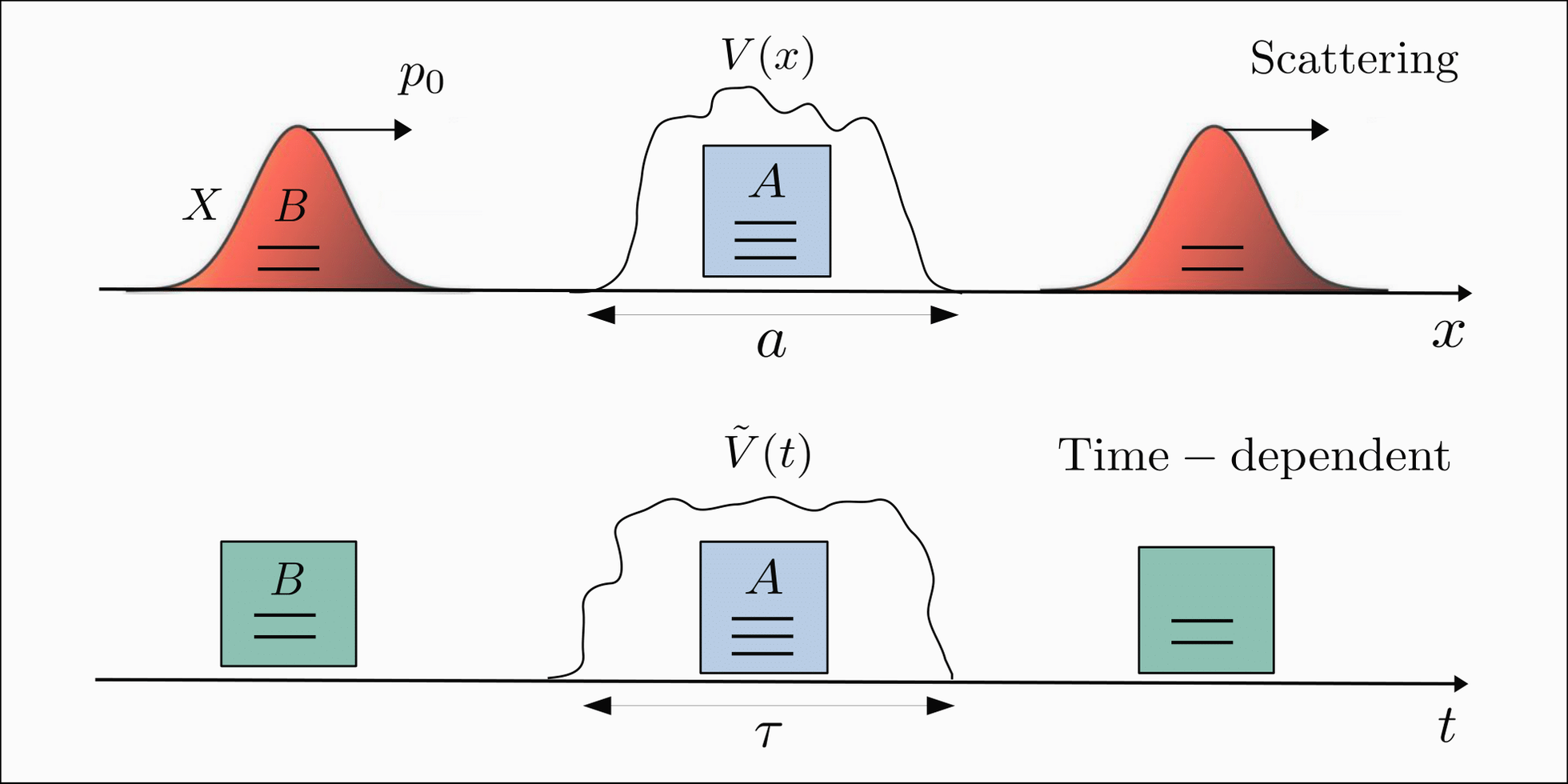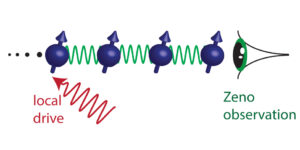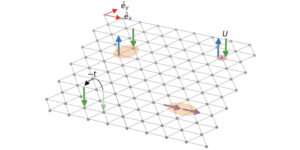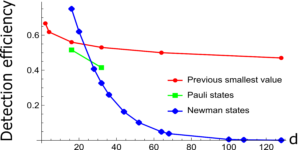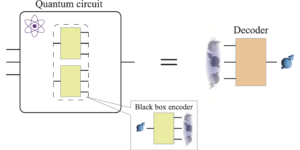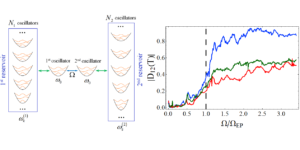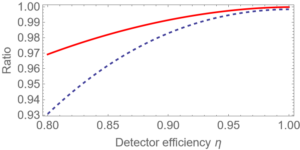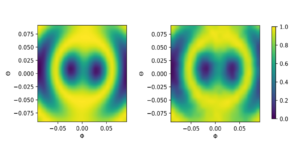1Complex Systems and Statistical Mechanics, Physics and Materials Science Research Unit, University of Luxembourg, L-1511 Luxembourg, G.D. Luxembourg
2Kavli Institute for Theoretical Physics, University of California, Santa Barbara, CA 93106 Santa Barbara, U.S.A.
3Departamento de Estructura de la Materia, Física Térmica y Electrónica and GISC, Universidad Complutense Madrid, 28040 Madrid, Spain
4Departamento de Física, Facultad de Ciencias Físicas y Matemáticas, Universidad de Chile, 837.0415 Santiago, Chile
Find this paper interesting or want to discuss? Scite or leave a comment on SciRate.
Abstract
We consider a collision between a moving particle and a fixed system, each having internal degrees of freedom. We identify the regime where the motion of the particle acts as a work source for the joint internal system, leading to energy changes which preserve the entropy. This regime arises when the particle has high kinetic energy and its quantum state of motion is broad in momentum and narrow in space, whether pure or mixed. In this case, the scattering map ruling the dynamics of the internal degrees of freedom becomes unitary and equivalent to that of a time-dependent interaction between the internal degrees of freedom of the colliding systems. It follows that the kinetic energy lost by the particle during the autonomous quantum collision coincides with the work performed by the time-dependent interaction. Recently, collisions with particles were shown to act as heat sources under suitable conditions; here we show that they can also act as work sources. This opens interesting perspectives for quantum thermodynamics formulations within scattering theory.
Featured image: Scattering and time-dependent setups considered in our study. In the former, the interaction happens autonomously in space through a potential $V(x)$: system $A$ is fixed while the incoming particle has kinetic degrees of freedom $X$ and internal degrees of freedom $B$. In the latter, the interaction between $A$ and $B$ happens in time through a time-dependent interaction $tilde{V}(t)$. Note that the potentials $V(x)$ and $tilde{V}(t)$ are generally not the same.
Popular summary
This paper considers the scattering of an incoming particle by a fixed system. We show that this scattering process models a repeated interaction model on the internal structure of the joint particle-system when the particle has high kinetic energy and its quantum state of motion is broad in momentum and narrow in space, whether pure or mixed — work results, in this case, from kinetic energy changes of the incoming particle. Since conditions for incoming particles to behave as a heat source have also been recently identified, our work suggests that scattering problems may provide a rich terrain to explore quantum thermodynamics.
► BibTeX data
► References
[1] H.-P. Breuer and F. Petruccione. The Theory of Open Quantum Systems. Oxford University Press, Oxford, 2007. 10.1093/acprof:oso/9780199213900.001.0001.
https://doi.org/10.1093/acprof:oso/9780199213900.001.0001
[2] A. Rivas and S. F. Huelga. Open Quantum Systems. Springer, Berlin, 2012. 10.1007/978-3-642-23354-8.
https://doi.org/10.1007/978-3-642-23354-8
[3] E. T. Jaynes and F. W. Cummings. Comparison of quantum and semiclassical radiation theories with application to the beam maser. Proceedings of the IEEE, 51 (1): 89–109, 1963. 10.1109/PROC.1963.1664.
https://doi.org/10.1109/PROC.1963.1664
[4] C. Cohen-Tannoudji, B. Diu, and F. Laloe. Quantum Mechanics, Volume 2: Angular Momentum, Spin and Approximations Methods. John Wiley & Sons, 1991.
[5] C. Cohen-Tannoudji, J. Dupont-Roc, and G. Grynberg. Atom-Photon Interactions: Basic Processes and Applications. John Wiley & Sons, 1998. 10.1002/9783527617197.
https://doi.org/10.1002/9783527617197
[6] S. Haroche and J.-M. Raimond. Exploring the Quantum: Atoms, Cavities, and Photons. Oxford University Press, Oxford, 2006. 10.1093/acprof:oso/9780198509141.001.0001.
https://doi.org/10.1093/acprof:oso/9780198509141.001.0001
[7] Y. Aharonov and D. Bohm. Time in the quantum theory and the uncertainty relation for time and energy. Physical Review, 122 (5): 1649–1658, 1961. 10.1103/PhysRev.122.1649.
https://doi.org/10.1103/PhysRev.122.1649
[8] M. P. Woods, R. Silva, and J. Oppenheim. Autonomous quantum machines and finite-sized clocks. Annales Henri Poincaré, 20 (1): 125–218, 2019. 10.1007/s00023-018-0736-9.
https://doi.org/10.1007/s00023-018-0736-9
[9] P. Talkner and P. Hänggi. Aspects of quantum work. Physical Review E, 93 (2), 2016. 10.1103/physreve.93.022131.
https://doi.org/10.1103/physreve.93.022131
[10] W. Niedenzu, M. Huber, and E. Boukobza. Concepts of work in autonomous quantum heat engines. Quantum, 3: 195, 2019. 10.22331/q-2019-10-14-195.
https://doi.org/10.22331/q-2019-10-14-195
[11] M. Esposito, K. Lindenberg, and C. Van den Broeck. Entropy production as correlation between system and reservoir. New Journal of Physics, 12 (1): 013013, 2010. 10.1088/1367-2630/12/1/013013.
https://doi.org/10.1088/1367-2630/12/1/013013
[12] R. Kosloff. Quantum thermodynamics: A dynamical viewpoint. Entropy, 15 (12): 2100–2128, 2013. 10.3390/e15062100.
https://doi.org/10.3390/e15062100
[13] M. Perarnau-Llobet, K. V. Hovhannisyan, M. Huber, P. Skrzypczyk, N. Brunner, and A. Acín. Extractable work from correlations. Physical Review X, 5 (4): 041011, 2015. 10.1103/physrevx.5.041011.
https://doi.org/10.1103/physrevx.5.041011
[14] S. Vinjanampathy and J. Anders. Quantum thermodynamics. Contemporary Physics, 57 (4): 545–579, 2016. 10.1080/00107514.2016.1201896.
https://doi.org/10.1080/00107514.2016.1201896
[15] F. Binder, L. A. Correa, C. Gogolin, J. Anders, and G. Adesso, editors. Thermodynamics in the Quantum Regime. Springer, Cham, 2018. 10.1007/978-3-319-99046-0.
https://doi.org/10.1007/978-3-319-99046-0
[16] M. Razavy. Quantum Theory of Tunneling. World Scientific Publishing, Singapore, 2003. 10.1142/4984.
https://doi.org/10.1142/4984
[17] D. Belkić. Principles of quantum scattering theory. Institute of Physics Publishing, Bristol, 2004.
[18] J. R. Taylor. Scattering Theory: The Quantum Theory of Nonrelativistic Collisions. Dover Publications, New York, 2006.
[19] Y. V. Nazarov and Y. M. Blanter. Quantum Transport. Cambridge University Press, Cambridge, 2009. 10.1017/cbo9780511626906.
https://doi.org/10.1017/cbo9780511626906
[20] A. Bruch, C. Lewenkopf, and F. von Oppen. Landauer-büttiker approach to strongly coupled quantum thermodynamics: Inside-outside duality of entropy evolution. Physical Review Letters, 120 (10): 107701, 2018. 10.1103/PhysRevLett.120.107701.
https://doi.org/10.1103/PhysRevLett.120.107701
[21] R. Dümcke. The low density limit for an N-level system interacting with a free Bose or Fermi gas. Communications in Mathematical Physics, 97 (3): 331–359, 1985. 10.1007/BF01213401.
https://doi.org/10.1007/BF01213401
[22] K. Hornberger, S. Uttenthaler, B. Brezger, L. Hackermüller, M. Arndt, and A. Zeilinger. Collisional decoherence observed in matter wave interferometry. Physical Review Letters, 90 (16), 2003. 10.1103/physrevlett.90.160401.
https://doi.org/10.1103/physrevlett.90.160401
[23] K. Hornberger. Master equation for a quantum particle in a gas. Physical Review Letters, 97 (6), 2006. 10.1103/physrevlett.97.060601.
https://doi.org/10.1103/physrevlett.97.060601
[24] K Hornberger. Monitoring approach to open quantum dynamics using scattering theory. Europhysics Letters, 77 (5): 50007, 2007. 10.1209/0295-5075/77/50007.
https://doi.org/10.1209/0295-5075/77/50007
[25] K. Hornberger and B. Vacchini. Monitoring derivation of the quantum linear boltzmann equation. Physical Review A, 77 (2), 2008. 10.1103/physreva.77.022112.
https://doi.org/10.1103/physreva.77.022112
[26] M. Lostaglio. An introductory review of the resource theory approach to thermodynamics. Reports on Progress in Physics, 82 (11): 114001, 2019. 10.1088/1361-6633/ab46e5.
https://doi.org/10.1088/1361-6633/ab46e5
[27] S. L. Jacob, M. Esposito, J. M. R. Parrondo, and F. Barra. Thermalization induced by quantum scattering. PRX Quantum, 2 (2), 2021. 10.1103/prxquantum.2.020312.
https://doi.org/10.1103/prxquantum.2.020312
[28] L. D. Landau and E. M. Lifshitz. Quantum Mechanics : Non-relativistic Theory. Pergamon Press, Oxford, 1977. 10.1016/C2013-0-02793-4.
https://doi.org/10.1016/C2013-0-02793-4
[29] J. J. Sakurai. Modern Quantum Mechanics (Revised Edition). Addison-Wesley, 1993.
[30] F. Barra. The thermodynamic cost of driving quantum systems by their boundaries. Scientific Reports, 5 (1), 2015. 10.1038/srep14873.
https://doi.org/10.1038/srep14873
[31] S. Strasberg, G. Schaller, T. Brandes, and M. Esposito. Quantum and information thermodynamics: A unifying framework based on repeated interactions. Physical Review X, 7 (2), 2017. 10.1103/physrevx.7.021003.
https://doi.org/10.1103/physrevx.7.021003
[32] F. L. S. Rodrigues, G. De Chiara, M. Paternostro, and G. T. Landi. Thermodynamics of weakly coherent collisional models. Physical Review Letters, 123 (11): 140601, 2019. 10.1103/PhysRevLett.123.140601.
https://doi.org/10.1103/PhysRevLett.123.140601
[33] G. Guarnieri, D. Morrone, B. Çakmak, F. Plastina, and S. Campbell. Non-equilibrium steady-states of memoryless quantum collision models. Physics Letters A, 384 (24): 126576, 2020. 10.1016/j.physleta.2020.126576.
https://doi.org/10.1016/j.physleta.2020.126576
[34] J. Monsel, M. Fellous-Asiani, B. Huard, and A. Auffèves. The energetic cost of work extraction. Physical Review Letters, 124: 130601, 2020. 10.1103/PhysRevLett.124.130601.
https://doi.org/10.1103/PhysRevLett.124.130601
[35] J. Tabanera, I. Luque, S. L. Jacob, M. Esposito, F. Barra, and J. M. R. Parrondo. Quantum collisional thermostats. New Journal of Physics, 24 (2): 023018, 2022. 10.1088/1367-2630/ac4923.
https://doi.org/10.1088/1367-2630/ac4923
[36] K. M. R. Audenaert and S. Scheel. On random unitary channels. New Journal of Physics, 10 (2): 023011, 2008. 10.1088/1367-2630/10/2/023011.
https://doi.org/10.1088/1367-2630/10/2/023011
[37] S. Blanes, F. Casas, J.A. Oteo, and J. Ros. The magnus expansion and some of its applications. Physics Reports, 470 (5): 151–238, 2009. 10.1016/j.physrep.2008.11.001.
https://doi.org/10.1016/j.physrep.2008.11.001
[38] B.-G. Englert, J. Schwinger, A. O. Barut, and M. O. Scully. Reflecting slow atoms from a micromaser field. Europhysics Letters, 14 (1): 25–31, 1991. 10.1209/0295-5075/14/1/005.
https://doi.org/10.1209/0295-5075/14/1/005
[39] S. Haroche, M. Brune, and J. M. Raimond. Trapping atoms by the vacuum field in a cavity. Europhysics Letters, 14 (1): 19–24, 1991. 10.1209/0295-5075/14/1/004.
https://doi.org/10.1209/0295-5075/14/1/004
Cited by
[1] Jorge Tabanera, Inés Luque, Samuel L. Jacob, Massimiliano Esposito, Felipe Barra, and Juan M. R. Parrondo, "Quantum collisional thermostats", New Journal of Physics 24 2, 023018 (2022).
The above citations are from SAO/NASA ADS (last updated successfully 2022-07-16 00:56:19). The list may be incomplete as not all publishers provide suitable and complete citation data.
On Crossref's cited-by service no data on citing works was found (last attempt 2022-07-16 00:56:18).
This Paper is published in Quantum under the Creative Commons Attribution 4.0 International (CC BY 4.0) license. Copyright remains with the original copyright holders such as the authors or their institutions.

